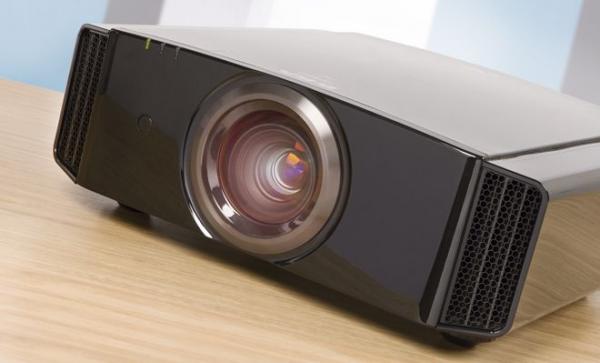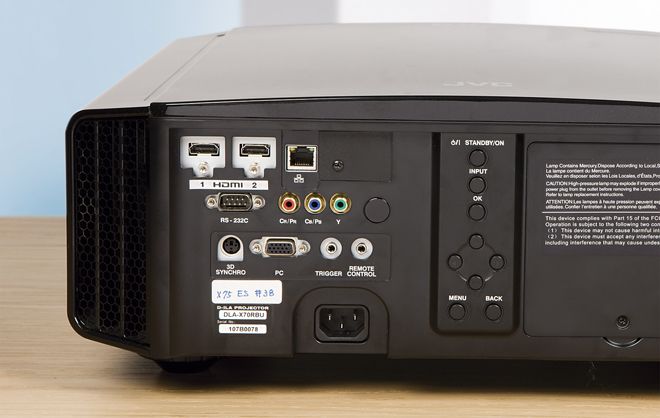JVC DLA-X75 review

While we rapturously praised JVC’s decision to turn its traditional D-ILA projection trio into a quartet this year when reviewing the outstanding DLA-X55 addition to the range, it occurred to us that that model's excellence potentially caused the brand a problem. In previous years the step up from JVC’s entry-level projectors to the mid-range equivalents of this year’s DLA-X75 was clearly defined. Now, though, you may wonder if the DLA-X75 can up the ante enough from the DLA-X55 to justify its extra £1,500 or so cost.
With this in mind, it seems sensible to try and get to grips with the key feature differences between the DLA-X55 and the DLA-X75 right from the off. A couple can be spotted just by looking at the two projectors’ top edges. The DLA-X75 sports extra THX and ISF logos, revealing that it’s won the independent backing of both the THX image quality assurance group and the Imaging Science Foundation calibration gang.
The THX logo means you get a couple of pre-calibrated, movie-friendly THX presets and picture quality that’s essentially guaranteed to rock, while the ISF logo means you get a comprehensive suite of picture calibration tools.
Tweaks that the DLA-X75 offers over and above those of its sibling include a powerful seven-axis colour management system, a wide range of greyscale and gamma adjustments, and 10 lens memory slots, versus the DLA-X55’s five. These lens memories are there so you can store different zoom and focus settings for different film aspect ratios – handy if you’ve got a 21:9 screen and don’t want to bother with an external anamorphic lens rig.
More evidence of the DLA-X75’s ‘high-end’ ambition can be seen in its provision of a D-Sub PC port and the way its Ethernet port enables the projector to autocalibrate itself in conjunction with a PC and (not supplied) optical sensor.
Perhaps the single most important advantage over the DLA-X55, though, is its claimed contrast ratio of 90,000:1. The DLA-X55 offers 40,000:1.
The enormous contrast ratios I'm bandying around here are native figures. JVC’s projectors can achieve them without having to manipulate the amount of light being used. Experience has proven that this allows JVC’s PJs to deliver images with exceptional dynamism, shadow detail and stability.
 It's good to share
It's good to share
Naturally, not everything about the DLA-X75 is different from the DLA-X55. Important shared features – aside from the use of D-ILA chipsets and wire grid polarisers to deliver those stunning native contrast figures – are Active 3D playback and e-Shift 2 image processing.
Despite using the 4K ‘buzzword’, e-Shift 2 does not make the JVC a 4K projector in the usual/true sense of the word. It doesn’t carry native 3,840 x 2,160 pixel chipsets and it can’t handle native 4K sources. What it does do, though, is pass images through two 1,920 x 1,080 display devices offset from each other diagonally by half a pixel, so that the resulting images have twice their native pixel density.
Like the DLA-X55, this model offers a degree of flexibility over how the e-Shift system works, enabling you to finetune the degree of sharpening impact it applies to your HD and standard-definition sources.
As with most elements of the JVC's setup and feature menus, the ‘4K’ adjustments are presented cleanly, aside from one or two bits of jargon. In fact, despite its high level of specification the DLA-X75 is easy to get up and running, not least because of its motorised zoom, focus and horizontal/vertical lens adjustments, and the range it provides across all of these physical adjustments.
All the feature and spec improvements in the DLA-X75 will mean diddly squat, of course, if they don’t lead to a noticeable improvement in picture quality. But happily they do.
The most obvious performance leap comes in the contrast department. Dark scenes like those in Gollum’s caves in The Hobbit: An Unexpected Journey exhibit levels of blackness and contrast emphatically beyond those of the DLA-X55 – and the DLA-X55 is itself uniquely accomplished in contrast terms for its price point.
The DLA-X75’s deep blacks are achieved without sacrificing shadow detail – in fact, there seems to be more visible detail in the background walls of Gollum’s domain than on its baby brother. It also serves up punchy whites and colours right alongside these peerless blacks, and without ‘jumping’ brightness levels; dark scenes remain utterly stable.
Serious film fans not afraid to setup a properly blacked-out viewing room will really feel the benefit of the DLA-X75’s extra black levels over the DLA-X55 – to a degree, I suspect, that will make them feel it’s well worth the extra £1,500.

Reinforcing this impression is the way this model's extra contrast and superior optical components eke out more impact from the e-Shift 2 4K system. There’s a greater sense of extra image density and texture, while the improved contrast range helps you better appreciate the sense of depth and colour nuancing that e-Shift 2 can produce.
I must stress that e-Shift 2's 4K efforts don’t result in pictures as detailed and immaculate as those delivered by the new generation of Ultra HD TVs. But I will argue that the DLA-X75’s approach to adding more pixels to HD pictures seems more natural and less intrusive than the processing impact of even the very best upscaling systems on native 4K displays. Meanwhile, going back to watching HD images on a projector without the e-Shift tech feels almost painful.
Earlier I mentioned the DLA-X75’s impressive colour handling, but this warrants more discussion. Everything from the difficult and varied palette of Casino Royale through to the riotous colourscape of Oz The Great and Powerful is handled sublimely well. There's naturalism, balance and precision in abundance, as long as you’re careful which of the provided presets you use.
Wrapping up a sensational picture performance is the DLA-X75’s handling of 3D. Favourite stereoscopic fare such as Avatar and Life of Pi looks mostly excellent, with huge amounts of HD detail in the 3D frame; a great and natural sense of depth aided by the potent contrast range; and fluid motion handling. Best of all, there’s far, far less crosstalk noise than I witnessed with last year’s JVC 3D projectors.
Striving for perfectionIn a perfect world the DLA-X75’s pictures might look a touch brighter, and the projector would run slightly more quietly in 3D mode (which makes its lamp have to work harder). But I expect most people with £6,500 to spend on a projector will probably have the wherewithal to work round these relatively minor niggles.
For many people without limitless supplies of cash, JVC’s DLA-X55 will remain the ‘go to’ model from the company's latest projection range. At the same time, though, the DLA-X75 offers more reasons than I'd expected for serious cinema fans to spend an extra £1,500, and certainly cements JVC’s fearsome reputation as the most consistently outstanding projector brand operating in the sub-£10,000 bracket today. Grab an audition as soon as you can.
HCC VERDICT
 JVC DLA-X75
JVC DLA-X75
Price: £6,500 Approx
www.jvc.co.uk
Highs: Spectacular, contrast-rich picture quality; runs quietly in low lamp mode; flexible setup; e-Shift 2 works well
Lows: Runs a bit noisily in 3D mode; 3D images aren’t the brightest; the DLA-X55 pushes it hard
Performance: 5/5
Design: 4/5
Features: 5/5
Overall: 5/5
 |
Home Cinema Choice #351 is on sale now, featuring: Samsung S95D flagship OLED TV; Ascendo loudspeakers; Pioneer VSA-LX805 AV receiver; UST projector roundup; 2024’s summer movies; Conan 4K; and more
|























































